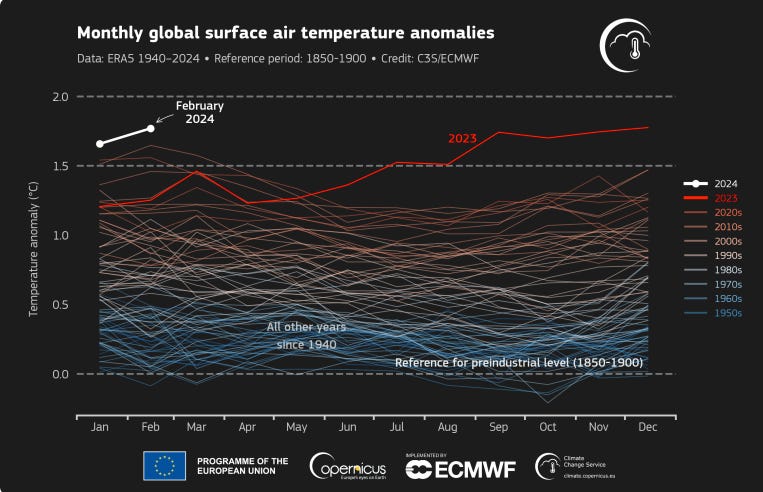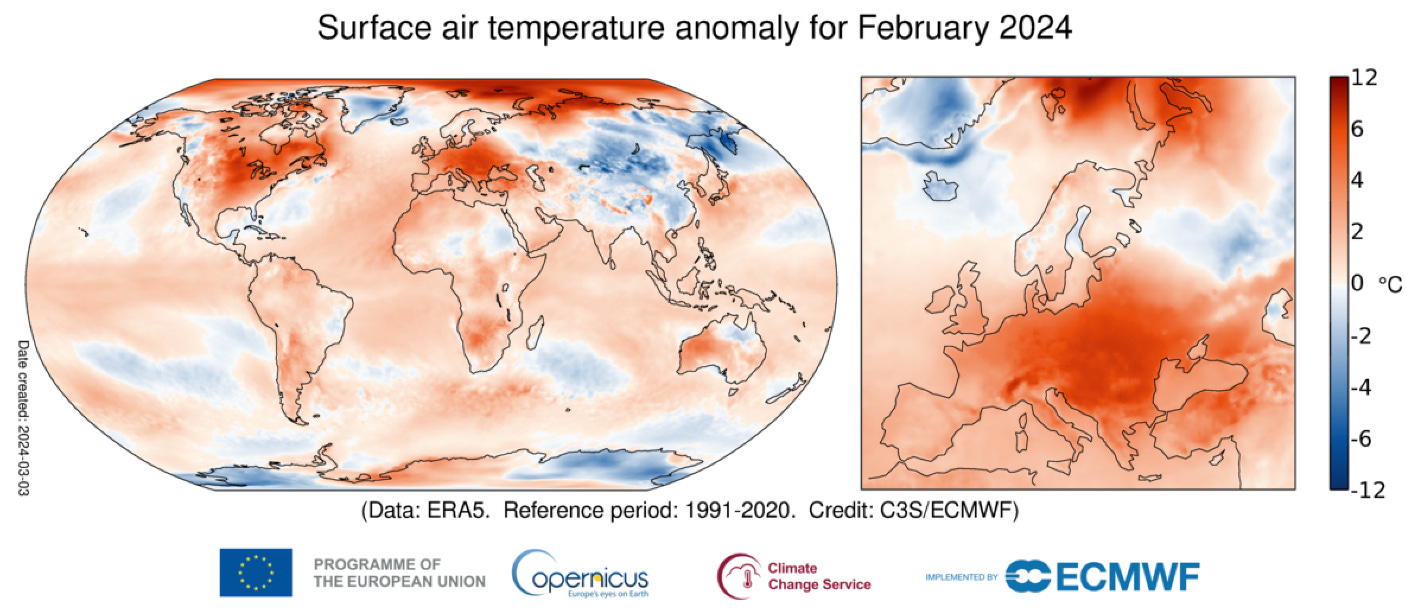🌡️ Breaking temperature records
Signal #05- Weekly Insights to rise above the sea of noise.
📊 - El Niño pushes temperatures to unprecedented highs
In 2023, we witnessed the hottest year on record, with temperatures soaring 1.45 degrees Celsius above pre-industrial levels (1850-1900). This anomaly further intensified in February 2024, which was 1.77 degrees above the average, marking an unprecedented high in our climate records. While El Niño played a significant role in this short-term spike, it doesn’t diminish the real impact of the global warming trend.
Monthly global surface air temperature anomalies. Data: ERAS 1940-2024. Reference period: 1850-1900. Credit: C3S/ECMWF, Link
Short Temperature cycles
The recent temperature records might feel overwhelming, especially in light of the Paris Agreement, which aims to limit global warming to well below 2 degrees Celsius above pre-industrial levels this century, attempting to cap the increase at 1.5 degrees Celsius. But instead of being scared by this new reality, let's first understand temperature cycles.
El Niño, which we saw as the culprit of recent temperature records, is a phase of a natural cycle temperature, in the Pacific ocean waters, known as the El Niño-Southern Oscillation (ENSO) cycle.
Sea surface temperature since 2000, showcasing the current el Niño. Data from NOAA
During strong El Niño phases, like last February, the ocean typically acting as a heat store distributes this extra warmth to the atmosphere. As a result, we see temporary increases in air temperatures worldwide (i.e. correlation between El Niño and record temperatures).
Long temperature cycles
While ENSO phases, changing roughly every 2 to 7 years, are noticeable on the human timescale, there are also temperature cycles that are measured in thousands of years.
Temperature change over the last 100,000 years, highlighting the stability of the climate in the Holocene (IGBP, 2014) source. Temperature derived from isotopic concentrations in ice sheets (I believe), see water isotopes as paleothermometers for more context.
In the above graph, we can notice two interesting phenomena:
1- Over the last 100’000 years, we have seen, and survived, extreme temperature variations (on long timescales), without technology.
2- Our sedentary lifestyle (supported by agriculture), was only possible due to an unusually stable temperature period, the Holocene.
These long term fluctuations are primarily attributed to changes in solar radiation (highlighted by Milankovitch cycles), solar activity, and natural shifts in greenhouse gas concentrations, all understood through the lens of radiative forcing.
So what’s all the fuss about ?
This brings us to the crux of the matter: Climate variability is a complex and multifaceted phenomenon. So, what role do we play in this dynamic, and what actions can we take? It becomes apparent that the term "pre-industrial levels" was selected for a reason. Since industrialization, human activity has significantly increased atmospheric concentrations of greenhouse gases, such as carbon dioxide (CO2) and methane (CH4), exacerbating the natural greenhouse effect.
Work based on "Methane" by Reg Morrison, published on September 26, 2011. Modifications were made. The original work can be found here, licensed under a Creative Commons Attribution-NonCommercial-ShareAlike 2.5 Australia License.
These greenhouse gases increase the radiative forcing, a concept used in climate science to quantify the change in energy balance in the Earth's atmosphere. The IPCC summarised the current scientific consensus: “Human-caused radiative forcing of 2.72 [1.96 to 3.48] W/m^2 in 2019 relative to 1750 has warmed the climate system. This warming is mainly due to increased GHG concentrations, partly reduced by cooling due to increased aerosol concentrations".
Radiative forcing (warming influence) of greenhouse gases, based on data from NOAA. Data source: Table 2. Global Radiative Forcing, CO2-equivalent mixing ratio, and the AGGI 1979-2022 — Link: https://gml.noaa.gov/aggi/aggi.html
The impacts
Unless we opt for geoengineering approaches—such as by intentionally releasing sulfur dioxide (SO2) into the atmosphere to reflect sunlight away from Earth, replicating the natural cooling effects of large volcanic eruptions—it is well-established that we will persist in facing global warming.
So we not only need to aggressively reduce greenhouse gas emissions, but also to develop and implement adaptive measures across sectors like agriculture, public health, and infrastructure to mitigate the effects of rising temperatures.
This imperative is underscored by the uneven impact of climate change across different regions. This is well represented below by comparing the air temperature anomaly of February 2024, which we saw as record breaking, to 1991-2020 averages.
February 2024: The Warmest February on Record According to Copernicus Climate Change Service, 7 March 2024, Link.
The last piece of bad news, that we need to hear, is that there are feedback loops that could accelerate change. We saw there is significant natural climate variability and cycles, which are challenging to model. To further complicate the situation, there are several systems at risk of acting as natural accelerators to the global warming.
Scientists Examine Dangerous Global Warming ‘Accelerators’, By Bob Berwin, February 17, 2023, Link.
Wrapping it up
The latest temperature records, and the intricate dance between human activity and Earth's climate system underscore a stark reality: we are at a pivotal moment.
Human activity is impacting the planet’s climate at unprecedented levels.
Climate change is impacting humans and ecosystems at unprecedented levels.
It's a reminder that the choices we make today—ranging from individual decisions to global policy—will shape our legacy and the world for future generations. The path forward requires a holistic approach, combining emission reductions, technological innovation, and adaptation strategies.
💡 - Circular economy to cut emissions
The circular economy is an approach to sustainability, emphasizing the reuse, repair, and recycling of products and materials. By extending the lifecycle of resources, we can minimize waste and reduce the need for new materials, thus significantly cutting emissions. This stands in contrast to the traditional linear economy, which follows a 'take-make-discard' approach, contributing to an increased carbon footprint.
For example, by renting a down jacket, sleeping bag, and pair of pants for a recent trek in Nepal instead of buying them, I reduced my emissions by approximately 50kg CO2eq (1). However, the emissions saved through this single act are minor compared to the carbon footprint of a long-haul flight from Kathmandu to Paris, estimated at 700-800kg of CO2eq.
But the circular economy doesn't operate in isolation; it can coexist and synergize with innovative economic models. On the bumpy road from Kathmandu to Pokhara, I was astonished to see electric vehicle charging stations. I hope the money I injected into the local economy will be used towards the electrification of one of the most polluting transportation systems I have witnessed.
🔗 - Check these out
Decathlon’s buy back system promoting circular economy.
Dig deeper into methane’s impact on climate change.
July 2023 map of climate change








